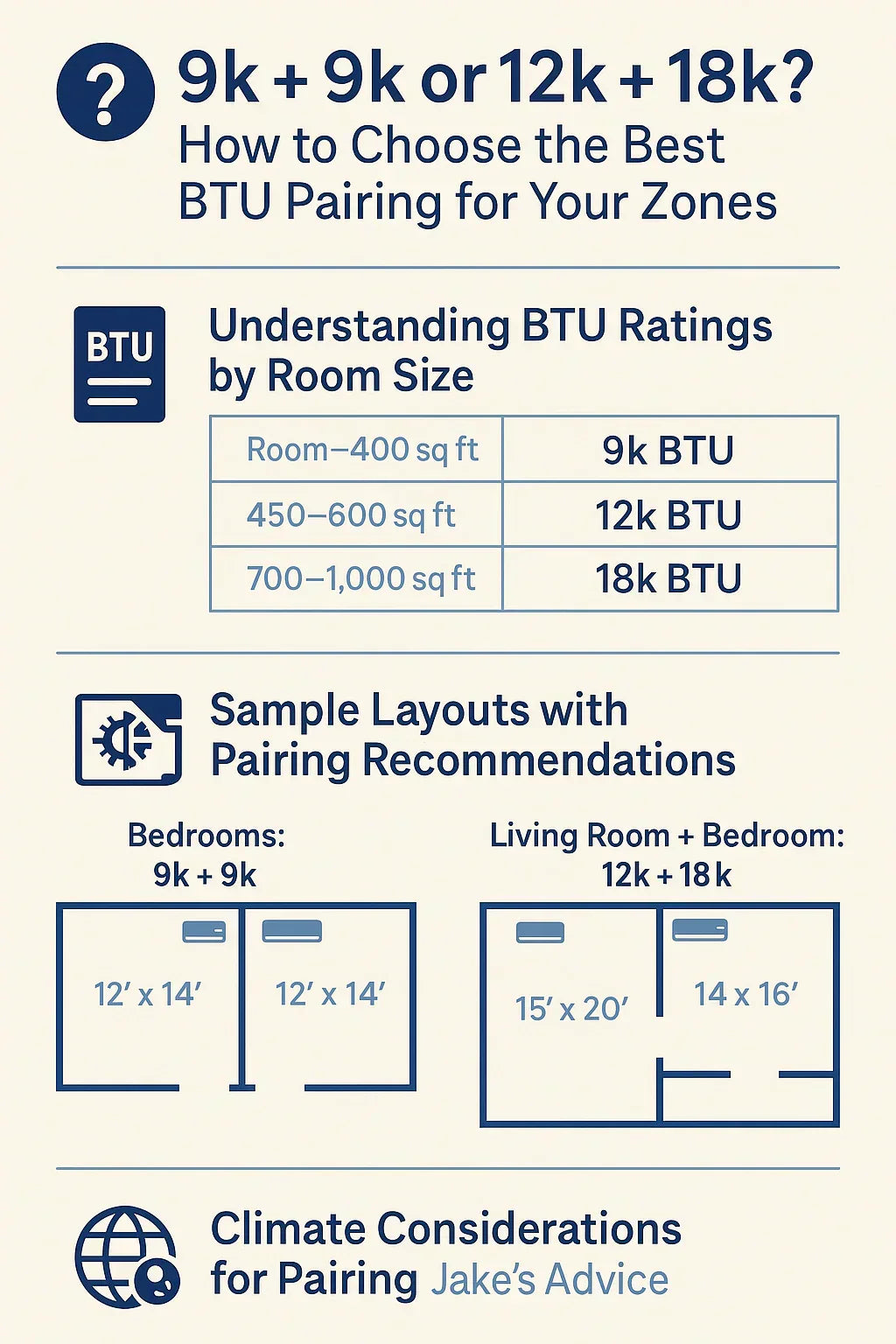Choosing the right BTU pairing for your 2-zone mini split system isn’t just about square footage. It’s about room function, insulation, ceiling height, and how your household actually lives day to day. In this long-form guide, we’ll compare 9k + 9k and 12k + 18k configurations across real-world scenarios to help you get the best performance and comfort out of your ductless system.
🏠 What Is a BTU and Why Does It Matter?
A BTU, or British Thermal Unit, is the amount of energy required to raise the temperature of one pound of water by one degree Fahrenheit. In HVAC terms, BTUs measure heating and cooling capacity. The higher the BTU rating, the more powerful the unit.
When you match your mini split's BTUs to your room's cooling/heating load, you ensure energy efficiency and long-term performance. Mismatched sizing can lead to short cycling, uneven temperatures, or wasted energy.
🔍 Understanding BTU Ratings by Room Size
Here are general guidelines from Energy Star’s BTU chart:
| Room Size (sq ft) | BTUs Needed |
|---|---|
| Up to 300 | 6,000 |
| 300–450 | 9,000 |
| 450–600 | 12,000 |
| 600–800 | 18,000 |
| 800–1,000 | 24,000 |
Remember, this is a baseline. Factors like sun exposure, insulation, climate, and ceiling height can skew these numbers.
🧹 Who Should Choose 9k + 9k?
Best for:
-
Apartments with two small bedrooms
-
Home office + den setups
-
Homes in mild climates
-
Lower ceilings (8 ft or less)
Typical room sizes: 250–400 sq ft each
Benefits:
-
Lower upfront cost
-
Lower power consumption
-
Ideal if you don’t use both rooms at the same time
Example Layout:
-
Bedroom 1: 12’x14’ (9k BTU)
-
Bedroom 2: 12’x14’ (9k BTU)
-
Combined usage: ~800 sq ft total
These setups are particularly efficient when insulation is solid and you're not dealing with high summer temps or sub-zero winters.
🏡 Who Should Choose 12k + 18k?
Best for:
-
Open concept living + bedroom setups
-
Converted garages or workshops
-
Homes in hot or humid climates
-
Rooms with high ceilings or poor insulation
Typical room sizes:
-
12k BTU = 450–600 sq ft
-
18k BTU = 600–900+ sq ft
Benefits:
-
Handles high heat loads better
-
Ideal for sunny rooms or kitchen/living combos
-
More forgiving if layout is open
Example Layout:
-
Living Room: 18’x22’ (18k BTU)
-
Bedroom: 13’x15’ (12k BTU)
-
Combined usage: ~1,400 sq ft
This pairing is especially effective in southern states like Texas, Florida, or Arizona where heat and humidity demand more cooling power.
🌍 How Climate Affects BTU Needs
According to the U.S. DOE Climate Zone Map, different areas of the country require different BTU levels.
| Zone | Region Example | Sizing Tip |
| 1-3 | Florida, Texas, Arizona | Add 15-25% more BTUs for cooling |
| 4 | Mid-Atlantic | Standard BTU recommendations |
| 5-7 | New England, Midwest | Boost BTUs for heating season |
For heating, choose models rated for low ambient performance
📊 Cost Comparison: Upfront and Operating
| Configuration | Equipment Cost | Operating Cost | Installation Impact |
| 9k + 9k | $$ | $ | Simple |
| 12k + 18k | $$$ | $$ | May need larger lineset, condenser |
Higher BTUs = higher initial cost, but not necessarily higher ongoing utility bills. Modern systems with inverter tech like MRCOOL DIY modulate power for better efficiency.
⚡ Efficiency and Comfort Trade-Offs
Risks of Undersizing:
-
Unit runs constantly
-
May not cool the space fully
-
Shortens compressor lifespan
Risks of Oversizing:
-
Short cycling (turns off/on frequently)
-
Poor humidity control
-
Wasted upfront investment
The goal: Right-size each zone based on actual load, not just square footage.
📏 Sample Layouts with Ideal Pairings
🏠 Compact Apartment (900 sq ft)
-
Bedroom: 9’x12’ (9k)
-
Living: 12’x16’ (9k)
-
Best Choice: 9k + 9k
🏡 Small Home (1,200 sq ft)
-
Bedroom: 12’x15’ (12k)
-
Living + Kitchen: 20’x22’ (18k)
-
Best Choice: 12k + 18k
🛏️ Workshop + Home Office
-
Garage Conversion: 20’x20’ (18k)
-
Office: 12’x12’ (9k)
-
Alternate: 18k + 9k (if brand supports mixed pairing)
🛠️ Do Condenser Limits Matter?
Yes. Every outdoor unit has a BTU capacity limit.
Examples:
-
18k condenser: supports 9k + 9k
-
24k condenser: supports 12k + 12k
-
30k condenser: supports 12k + 18k
Some brands offer flexibility in pairing, while others (like MRCOOL) have tighter pairing rules. Always check the brand's spec sheet.
🚑 Health and Noise Considerations
-
9k BTU units are typically quieter: <22 dB
-
18k BTU units produce more airflow and fan noise
-
Filtration: All units offer washable filters, and some (like LG or Mitsubishi) include advanced ionizers or HEPA-grade filtration
Consumer Reports notes that ductless units avoid duct-based allergens and dust.
🌟 Final Take: Which Should You Choose?
| Use Case | Recommended Pairing |
| Two small bedrooms | 9k + 9k |
| Living + Bedroom (Open Plan) | 12k + 18k |
| Mild climate or tight envelope | 9k + 9k |
| Hot/humid climate | 12k + 18k |
| Converted garage + den | 18k + 12k |
🧵 Jake’s Pro Tip:
“Match your system to how you actually live. Don’t oversize for guests or rare events. Focus your budget where comfort matters most.”
🔗 Verified Resources & Tools
In the next topic we will know more about: What Makes 2-Zone Systems More Efficient Than Central HVAC for Some Homes?







